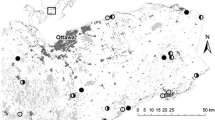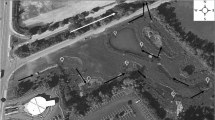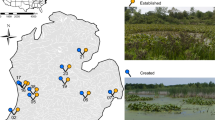Abstract
Created wetlands are increasingly used to mitigate wetland loss. Thus, identifying wetland creation methods that enhance ecosystem development might increase the likelihood of mitigation success. Noting that the microtopographic variation found in natural wetland settings may not commonly be found in created wetlands, this study explores relationships between induced microtopography, hydrology, and plant species richness/diversity in non-tidal freshwater wetlands, comparing results from two created wetland complexes with those from a mature reference wetland complex in northern Virginia. Elevation, steel rod oxidation depth, and species cover were measured along replicate multiscale (0.5 m-, 1 m-, 2 m-, and 4 m-diameter) tangentially conjoined circular transects in each wetland. Microtopography was surveyed using a total station and results used to derive three roughness indices: tortuosity, limiting slope, and limiting elevation difference. Steel rod oxidation depth was used to estimate water table depth, with data collected four times during the growing season for each study site. Plant species cover was estimated visually in 0.2 m2 plots surveyed at peak growth and used to assess species richness, diversity, and wetland prevalence index. Differences in each attribute were examined among disked and non-disked created wetlands and compared to a natural wetland as a reference. Disked and non-disked created wetlands differed in microtopography, both in terms of limiting elevation difference and tortuosity. However, both were within the range of microtopography encompassed by natural wetlands. Disked wetlands supported higher plant diversity and species richness than either natural or non-disked wetlands, as well as greater within-site species assemblage variability than non-disked wetlands. Irrespective of creation method, plant diversity in created wetlands was correlated with tortuosity and limiting elevation difference, similar to correlations observed for natural wetlands. Vegetation was more hydrophytic at disked sites than at non-disked sites, and of equivalent wetland indicator status to natural sites, even though all sites appeared comparable in terms of hydrology. Results suggest that disking may enhance vegetation community development, thus better supporting the goals of wetland mitigation.
Similar content being viewed by others
Literature Cited
Allmaras, R. R., R. E. Burwell, W. E. Larson, and R. F. Holt. 1966. Total porosity and random roughness of the interrow zone as influenced by tillage. USDA Conservation Research Report no. 7.
Bertuzzi, P., G. Rauws, and D. Courault. 1990. Testing roughness indexes to estimate soil surface-roughness changes due to simulated rainfall. Soil & Tillage Research 17: 87–99.
Bledsoe, B. P. and T. H. Shear. 2000. Vegetation along hydrologic and edaphic gradients in a North Carolina coastal plain creek bottom and implications for restoration. Wetlands 20: 126–47.
Bridgham, S. D., S. P. Faulkner, and C. J. Richardson. 1991. Steel rod oxidation as a hydrologic indicator in wetland soils. Soil Science Society of America Journal 55: 856–62.
Brose, U. 2001. Relative importance of isolation, area and habitat heterogeneity for vascular plant species richness of temporary wetlands in east-German farmland. Ecography 24: 722–30.
Brown, L. 1979. Grasses, an Identification Guide. Houghton Mifflin, Boston, MA, USA.
Bruland, G. L. and C. J. Richardson. 2005. Hydrologic, edaphic, and vegetative responses to microtopographic reestablishment in a restored wetland. Restoration Ecology 13: 515–23.
Clarke, K. R. and R. N. Gorley. 2006. PRIMER v6: User Manual/Tutorial. PRIMER-E Ltd, Plymouth, UK.
Clarke, K. R. and R. M. Warwick. 2001. Change in Marine Communities: An Approach to Statistical Analysis and Interpretation, second edition. PRIMER-E Ltd., Plymouth, UK.
Collins, S. L., J. V. Perino, and J. L. Vankat. 1982. Woody vegetation and microtopography in the bog meadow association of Cedar Bog, a west-central Ohio fen. American Midland Naturalist 108: 245–49.
Colwell, R. K. 2005. EstimateS: Statistical Estimation of Species Richness and Shared Species from Samples. Software and user’s guide, version 7.5, http://purl.oclc.org/estimates.
Federal Interagency Committee for Wetland Delineation. 1989. Federal manual for identifying and delineating jurisdictional wetlands. US Army Corps of Engineers, US Environmental Protection Agency, US Fish and Wildlife Service, USDA Soil Conservation Service, Washington, DC, USA.
Hansen, B., P. Schjonning, and E. Sibbesen. 1999. Roughness indices for estimation of depression storage capacity of tilled soil surfaces. Soil & Tillage Research 52: 103–11.
Harper, J. L., J. T. Williams, and G. R. Sagar. 1965. The heterogeneity of soil surfaces and its role in determining the establishment of plants from seed. Journal of Ecology 53: 273–86.
Harvey, J. W., J. T. Newlin, and J. Choi. 2003. Characterization of microtopography in the Everglades. p. 37–38. In G. R. Best (ed.) U.S. Geological Survey Greater Everglades Science Program: 2002 Biennial Report (open-file report 03-54). USGS, Tallahassee, FL, USA.
Hayek, L. C. and M. A. Buzas. 1997. Surveying Natural Populations. Columbia University Press, New York, NY, USA.
Huenneke, L. F. and R. R. Sharitz. 1986. Microsite abundance and distribution of woody seedlings in a South Carolina cypress-tupelo swamp. American Midland Naturalist 115: 328–35.
Jørgensen, S. E., R. Costanza, and F. -L. Xu (eds.). 2005. Handbook of Ecological Indicators for Assessment of Ecosystem Health. Taylor & Francis, Boca Raton, FL, USA.
Kamphorst, E. C., V. Jetten, J. Guerif, J. Pitkanen, B. V. Iversen, J. T. Douglas, and A. Paz. 2000. Predicting depressional storage from soil surface roughness. Soil Science Society of America Journal 64: 1749–58.
Larkin, D., G. Vivian-Smith, and J. B. Zedler. 2006. Topographic heterogeneity theory and ecological restoration. p. 142–64. In D. A. Falk, M. A. Palmer, and J. B. Zedler (eds.) Foundations of Restoration Ecology. Island Press, Washington, DC, USA.
Linden, D. R. and D. M. Van Doren. 1986. Parameters for characterizing tillage-induced soil surface-roughness. Soil Science Society of America Journal 50: 1560–65.
Maplesoft Inc. 2005. Maple 10. Waterloo Maple Inc., Waterloo, Canada.
Merrill, S. D. 1998. Comments on the chain method for measuring soil surface roughness: use of the chain set. Soil Science Society of America Journal 62: 1147–49.
Mitsch, W. J., N. Wang, L. Zhang, R. Deal, X. Wu, and A. Zuwerink. 2005. Using ecological indicators in a wholeecosystem wetland experiment. p. 213–37. In S. E. Jørgensen, R. Costanza, and F. -L. Xu (eds.) Handbook of Ecological Indicators for Assessment of Ecosystem Health. Taylor & Francis, Boca Raton, FL, USA.
Morzaria-Luna, H., J. C. Callaway, G. Sullivan, and J. B. Zedler. 2004. Relationship between topographic heterogeneity and vegetation patterns in a Californian salt marsh. Journal of Vegetation Science 15: 523–30.
National Drought Mitigation Center. 2005. U.S. Drought Monitor (accessed November 2006, available at http://drought. unl.edu/dm/).
National Research Council. 2001. Compensating for wetland losses under the Clean Water Act. National Academy Press, Boston, MA, USA.
Newcomb, L. 1977. Newcomb’s Wildflower Guide: An Ingenious New Key System for Quick, Positive Field Identification of the Wildflowers, Flowering Shrubs and Vines of Northeastern and North Central North America, first edition. Little Brown, Boston, MA, USA.
Norfolk District Army Corps of Engineers and Virginia Department of Environmental Quality. 2004. Recommendations for wetland compensatory mitigation: including site design, permit conditions, performance and monitoring criteria (accessed 7/29/2006 as http://www.deq.state.va.us/wetlands/pdf/ mitigationrecommendabbrevjuly2004.pdf).
Osborne, J. W. 2002. Notes on the use of data transformations. Practical Assessment, Research and Evaluation 8: 1–9.
Paratley, R. D. and T. J. Fahey. 1986. Vegetation — environment relations in a conifer swamp in central New York. Bulletin of the Torrey Botanical Club 113: 357–71.
Peach, M. and J. B. Zedler. 2006. How tussocks structure sedge meadow vegetation. Wetlands 26: 322–35.
Pepin, A. L. 2000. Correction of indicator status for Echinochloa crusgalli (Barnyard Grass). Virginia Association of Wetland Professionals Update 7: 4–5.
Pollock, M. M., R. J. Naiman, and T. A. Hanley. 1998. Plant species richness in riparian wetlands — A test of biodiversity theory. Ecology 79: 94–105.
Potter, K. N. and T. M. Zobeck. 1990. Estimation of soil microrelief. Transactions of the ASAE 33: 156–61.
Potter, K. N., T. M. Zobeck, and L. J. Hagan. 1990. A microrelief index to estimate soil erodibility by wind. Transactions of the ASAE 33: 151–55.
PRIMER-E Ltd. 2006. PRIMER v6.1. PRIMER-E Ltd., Plymouth, UK.
Reed, P. B. 1988. U.S. National Wetlands Inventory, U.S. Fish and Wildlife Service, U.S. National Interagency Review Panel, and U.S. Regional Interagency Review Panel: Northeast (Region 1). 1988. National list of plant species that occur in wetlands. Northeast (Region 1). U.S. Dept. of the Interior, Fish and Wildlife Service, Research and Development, Washington, DC, USA.
Reed, R. A., R. K. Peet, M. W. Palmer, and P. S. White. 1993. Scale dependence of vegetation-environment correlations — a case-study of a North Carolina piedmont woodland. Journal of Vegetation Science 4: 329–40.
Romkens, M. J. M. and J. Y. Wang. 1986. Effect of tillage on surface-roughness. Transactions of the ASAE 29: 429–33.
Romkens, M. J. M. and J. Y. Wang. 1987. Soil roughness changes from rainfall. Transactions of the ASAE 30: 101–07.
Saleh, A. 1993. Soil roughness measurement — chain method. Journal of Soil and Water Conservation 48: 527–29.
Sokkia Co. 1997. SET2110/SET3110/SET4110 Electronic Total Station: Operator’s Manual. Sokkia Co., Ltd., Tokyo, Japan.
Spieles, D. J. 2005. Vegetation development in created, restored, and enhanced mitigation wetland banks of the United States. Wetlands 25: 51–63.
SPSS Inc. 2004. SPSS 13.0 for Windows graduate student version. SPSS, Inc., Chicago, IL, USA.
Stohlgren, T. J., G. W. Chong, M. A. Kalkhan, and L. D. Schell. 1997. Multiscale sampling of plant diversity: effects of minimum mapping unit size. Ecological Applications 7: 1064–74.
Stolt, M. H., M. H. Genthner, W. L. Daniels, V. A. Groover, S. Nagle, and K. C. Haering. 2000. Comparison of soil and other environmental conditions in constructed and adjacent palustrine reference wetlands. Wetlands 20: 671–83.
Tiner, R. W., A. Rorer, R. H. Wiegand, Maryland. Dept. of Natural Resources., and U.S. Fish and Wildlife Service. 1988. Field Guide to Nontidal Wetland Identification. Maryland Dept. of Natural Resources Water Resources Administration; U.S. Dept. of the Interior Fish and Wildlife Service, Annapolis, MD & Newton Corner, MA, USA.
Titus, J. H. 1990. Microtopography and woody plant regeneration in a hardwood floodplain swamp in Florida. Bulletin of the Torrey Botanical Club 117: 429–37.
Tweedy, K. L., E. Scherrer, R. O. Evans, and T. H. Shear. 2001. Influence of microtopography on restored hydrology and other wetland functions (Meeting Paper No. 01-2061). In 2001 American Society of Agricultural Engineers Annual International Meeting. ASAE, St. Joseph, MI, USA.
Virginia FQAI Advisory Committee. 2004. Virginia wetlands plants C-value list (draft, accessed 7/26/2006 as http://www. deq.virginia.gov/wetlands/pdf/virginiacvaluescompleterevl.pdf). Commonwealth of Virginia, Office of Wetlands, Water Protection Compliance.
Vivian-Smith, G. 1997. Microtopographic heterogeneity and floristic diversity in experimental wetland communities. Journal of Ecology 85: 71–82.
Wentworth, T. R., G. P. Johnson, and R. L. Kologiski. 1988. Designation of wetlands by weighted averages of vegetation data — a preliminary evaluation. Water Resources Bulletin 24: 389–96.
Werner, K. J. and J. B. Zedler. 2002. How sedge meadow soils, microtopography, and vegetation respond to sedimentation. Wetlands 22: 451–66.
Wiens, J. A. 1989. Spatial scaling in ecology. Functional Ecology 3: 385–97.
Author information
Authors and Affiliations
Rights and permissions
About this article
Cite this article
Moser, K., Ahn, C. & Noe, G. Characterization of microtopography and its influence on vegetation patterns in created wetlands. Wetlands 27, 1081–1097 (2007). https://doi.org/10.1672/0277-5212(2007)27[1081:COMAII]2.0.CO;2
Received:
Accepted:
Issue Date:
DOI: https://doi.org/10.1672/0277-5212(2007)27[1081:COMAII]2.0.CO;2




